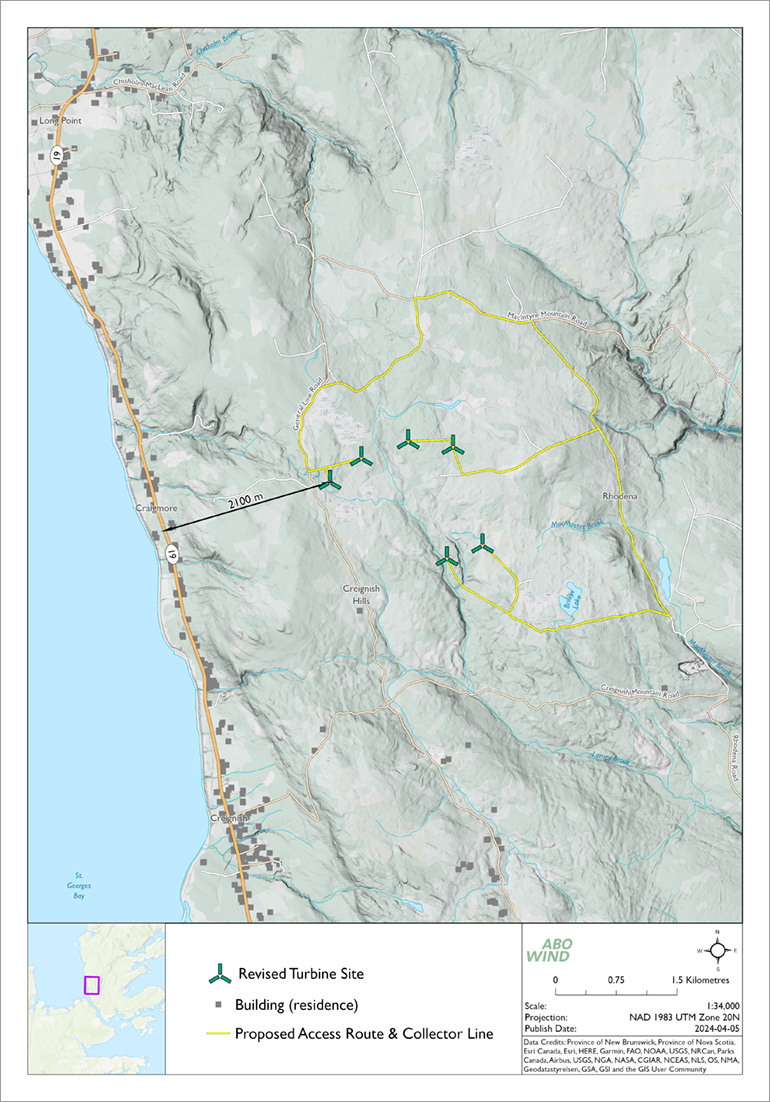Are wind turbines really that “green”?
Third-party studies have confirmed that wind turbines typically offset greenhouse gases emitted as part of their production and installation within the first year of operation. When the whole cycle of production and operations is considered, wind energy is recognized as one of the “greenest” or least carbon intensive forms of energy production.
How do you protect wildlife?
As part of the regulatory approval process, an environmental assessment will be undertaken to understand the relationship between wind turbines and the local environment. This is a requirement of the Province of Nova Scotia. Through this analysis, our team will make the necessary adjustments to the Project to avoid or reduce potential impact on wildlife.
How much tree clearing is needed?
By using existing roads and cleared areas as much as possible, we believe that we would need to clear 3 to 4 hectares per turbine, rather than the previously stated 5 to 6 hectares.
Is there any fear of contaminating groundwater downstream from the turbine construction area?
As part of the regulatory approval process, an environmental assessment will be undertaken to understand the relationship between wind turbines and the local environment. This includes wetlands, watercourses, fish habitat and groundwater. This is a requirement of the province of Nova Scotia. Through this analysis, the Proponent will make the necessary adjustments to the Project to avoid or minimize potential impact on water resources to the extent feasible.
What is the operational footprint of a turbine?
Depending on the turbine selected for the project, the concrete foundation for the turbine will range from 22 metres to 25 metres in diameter. Most of the foundation will be below ground and backfilled with soil.
Will any study be done on the impact of wildlife in the area such as bats, eagles, hawks, mainland moose, etc.?
If the Project proceeds, the Proponent is required to submit an application detailing the impact on the local environment to the Minister of Environment and Climate Change. These requirements are set out in provincial legislation and regulations, specifically the Environment Act and the Environmental Assessment Regulations. This will include impact on local wetlands, birds and threatened and protected species, such as mainland moose and bats.
Detailed studies, including multiple field surveys, supporting this application will be carried out by independent environment consultants. As of now, the Proponent has carried out initial desktop studies regarding the environment and species in the Project area, supported by field reconnaissance.
What will we see?
The visibility of each turbine depends on the viewpoint. On the Project website there are preliminary visual simulations prepared by a third party. During development, we will ask community representatives to offer more viewpoints for more detailed visualizations.
Will you be updating visual and noise assessments?
The proposed layout and turbine technology will likely change based on stakeholder, environmental and technical input. We will update the visual and sound assessments to reflect the most up-to-date plan as part of the environmental assessment process.
How big will the turbines be?
A few factors contribute to the choice of wind turbines, such as the wind profile and the height of nearby vertical obstacles. The Project is still at a preliminary stage. Once we have more wind data to tell us where the wind blows the strongest, we can choose a turbine. We anticipate that the hub height will range from about 100 metres to 125 metres with an approximate blade length between 60 metres and 85 metres.
Does low frequency noise (LFN) or infrasound from turbines impact human health?
There are over 75,000 operational wind turbines in Canada and United States and there are now over 100 peer-reviewed published scientific articles on the potential for health impacts living in proximity to wind turbines. Although audible sound, infrasound and low frequency noise (LFN) are emitted from wind turbines it is not at a level that causes health impacts, headaches, nausea, sleep problems and tinnitus. LFN or infrasound are a common occurrence produced from wind itself and other human sources including road traffic, refrigerators, air conditioners, farm machinery, and airplanes.
Infrasound can be defined as sound waves with frequencies below the lower limit of human hearing. We will design the Project to meet Nova Scotia’s regulations regarding audible sound criteria.
Humans are exposed to infrasound on a regular basis from several natural and engineered sources, at levels that generally exceed those produced by wind turbines. Additional information can be found at the Health Canada Wind Turbine Noise Study website: pamphlet-brochure-eng.pdf (canada.ca)
How much power will the Project generate?
This renewable energy project will involve up to 6 wind turbines, producing an estimated 42 megawatts of green energy – enough to power more than 13,600 homes annually!
Will safety lights have to be on all night?
Aviation warning lights on wind turbines are required by Transport Canada regulations. However, the Project is exploring the feasibility of light mitigation options to reduce the visibility to those on the ground.
Will the turbines be noisy?
During development, we will prepare a noise impact assessment with a map showing predicted sound emissions in relation to nearby residential properties. As the Project team gains more information about the wind, the engineers adjust their recommendations about turbine models. Once we have selected a model, more information will be made available related to sound.
What is infrasound and is it harmful to me?
Infrasound can be defined as sound waves with frequencies below the lower limit of human hearing. We will design the Project to meet Nova Scotia’s regulations regarding audible sound criteria.
Humans are exposed to infrasound on a regular basis from several natural and engineered sources, at levels that generally exceed those produced by wind turbines.
Will you be doing a Visual Impact Assessment or Noise Impact Assessment for my home?
We will prepare Visual Impact Assessments from several viewpoints around the Project as advised by the community. We will prepare a Noise Impact Assessment with a map showing sound emissions in relation to all nearby residential properties.
Have health issues been taken into consideration?
We respect that some individuals may have concerns regarding health. The Project will be designed to meet or exceed all provincial regulations and guidelines currently in place to protect human health.
Health Canada with Statistics Canada and other external experts conducted a Community Noise and Health Study on wind turbines. The results, which were released in 2014, indicated that wind turbine noise was not linked to self-reported medical illnesses and health conditions.
When and what are you submitting? What is involved in the permitting process?
ABO Wind Canada will submit a proposal in the Green Choice program issued by the Province of Nova Scotia. The submission deadline is now June 14, 2024. For more information: www.novascotiagcp.com. The Project will also be required to fulfill all requirements for a provincial Environmental Assessment.
Why is the Project this size?
Several factors contribute to the size of a project such as Rhodena Wind
- available lands under contract
- local electrical grid capacity
- wind profile
- local environmental features, and
- any applicable criteria outlined in the RFP
What is the consultation process?
ABO Wind strongly values positive community relations. It will be our practice to provide updates to the project at key milestones ensuring that First Nations and those living and working in the area have opportunities to discuss and comment through a variety of methods, including, phone, email, video meeting, and face-to-face meetings.
We want to hear from the community. Please contact us anytime through the form at www.rhodenawind.ca.
Has the proponent consulted with the local Indigenous community? What was their feedback on the project?
ABO Wind Canada acknowledges that the proposed project is located in Unima’ki (Cape Breton Island), within Mi’kma’ki, the ancestral, unceded territory of the Mi’kmaq people. We are grateful for the Treaties of Peace and Friendship with the Mi’kmaq people, which set out long-standing promises, mutual obligations, and benefits for all parties involved. We have active ongoing communication with Eskasoni and other First Nations communities. Eskasoni First Nation has provided a letter of support for the Rhodena Project.
How do we keep the community involved and up to date?
ABO Wind will send out updates on the Project via mail to addresses located in the areas surrounding the proposed Project. Updates will also be added to our website (www.rhodenawind.ca) so that those outside of the immediate Project area can remained informed. Advertisements in the local paper will also announce the release of these updates.
ABO Wind is working to establish a Community Liaison Committee for the Project. The committee would meet regularly to bring forward community concerns throughout the construction and life cycle of the wind site. If you are interested in possibly joining the CLC, please contact heidi.kirby@abo-wind.com.
Why not give a formal presentation with Q&A at the end? Why do an open house format?
The aim of the open house is to provide Project information and respond to questions or concerns in a safe and comfortable environment. Through experience, we have found that one- on-one or small-group conversations with posters allows people to learn about the project at their own pace, and to voice their questions and concerns without feeling the pressure of an audience.
What if I have more questions?
Please send questions and/or concerns to us through the form at www.rhodenawind.ca.
We will continue to update visualizations, maps and other information on the website. For general information, visit the Canadian Renewable Energy Association website: Canadian Renewable Energy Association - Wind. Solar. Storage. (renewablesassociation.ca)
What is ABO Wind doing to ensure adequate emergency access and preparedness for any risk of fire at the Project site?
ABO Wind and any other companies or contractors involved in this Project must have safety at top of mind and follow all safety and emergency response protocols, from site visits to construction and operations. As the Project developer, ABO is creating a Project-specific Emergency Management Plan (ERP) and completing Field Level Hazard Assessments when conducting onsite work. The ERP will be informed by industry best-practices, ABO’s global and Canadian expertise in developing wind farms, and local emergency responders. ABO has had initial outreach with local fire personnel and will further consult first responders to ensure alignment with local resources. The ERP will be comprehensive and include details about on-site and offsite resources to assist in suppressing and containing a fire on the Project site, along with other safety plans (and mitigation).
The Project will utilize existing access roads along with some new access roads as part of this Project. ABO Wind will work to ensure adequate emergency access, including identified egresses for the Project site are incorporated and shared as part of its Project safety planning.
Turbine fires are uncommon with an estimated probability of a wind turbine fire ranging between one in 2,000 to one in 7,000, according to Firetrace International (p.3). Modern turbines have smoke detection equipment installed within the nacelle, “the rectangle”, at the top of the tower. While the Proponent has not finalized the turbine model for the Project, it expects that the selected turbine will have smoke detection equipment. ABO recognizes these risks, no matter how small, are important to plan for and be prepared for – safety is paramount during all aspects of the Project’s construction and operational life.
How do you select the areas for the turbines?
There are many factors to consider in siting wind turbines, such as the following: our ability to keep setbacks to at least 1,000 metres from homes; the wind resource; environmental features; access to transmission lines; and the ability to access and build turbines at the location.
What type of road access is needed for the turbines?
We will require approximately 4 km of new roads and upgrading of 12km of existing roads for the Project. A 6-metre-wide road will be built for both construction and operations. New and existing road intersections will be widened temporarily for turbine delivery and reclaimed once turbine installation is completed.
What is the life expectancy of the Project?
The lifecycle of a turbine is typically 20 to 30 years. The life expectancy of this Project will be subject to the requirements set out by Nova Scotia Power within the Power Purchase Agreement, which we expect to be 25 years.
Is your schedule achievable?
The current Project schedule is subject to change depending on the criteria in the upcoming Request for Proposals (RFP).
Who maintains the turbines, access road, equipment, etc.?
The proponent will have a local operations team, including an operations manager who will be responsible for the wind farm’s maintenance program. Depending on the project’s turbine contract, the original equipment manufacturer (OEM) may be responsible for turbine maintenance and any required repairs for an agreed term of the project life. Local contractors are typically hired for maintenance items, such as road maintenance, snow removal, equipment service, etc.
Where will electricity generated from the Project go?
Power generated from this project will feed into the Nova Scotia grid.
The Green Choice Program (www.novascotiagcp.com) was developed to allow Nova Scotia’s large-scale energy customers to purchase up to 100% of their electricity use from local renewable energy sources, like the Rhodena Wind Project. This includes governments, Mi’kmaw band councils, public schools, universities, Nova Scotia Community College, healthcare facilities and non-profit organizations.
Can people continue using the land as they are (hunting, fishing, cutting wood)?
Project planning will be done to minimize restrictions on land use. Typically, most activities underway before construction of a wind site can continue afterwards.
How much money do landowners get and how do you calculate that?
For confidentiality reasons, all we can say is we propose contracts that are typical and competitive within this region and within the renewable energy industry.
What happens if the company goes bankrupt?
Under the rare circumstance of a renewable energy company going bankrupt, the inherent value in the operating wind facility remains. Typically, the major investors in the project will buy out the bankrupt company to ensure their investment is protected. A bankruptcy would not typically affect the operations of a wind facility, as the investment community understands the economic value of an operating electricity generation asset.
Are there provisions in the lease that you use for decommissioning wind turbines at the end of the project?
Project land contracts and regulatory approvals will contain requirements for reclamation and decommissioning. The Project will also complete a salvage value study before decommissioning turbines – to evaluate potential costs of salvaging compared to decommissioning costs. ABO Wind anticipates the salvage value of recovered metals (for example, copper, steel, rare earth metals) will cover a portion of decommissioning costs.
Will a turbine be placed on my land?
ABO Wind Canada has contracts in place with landowners who will have infrastructure on their property.
How close will a wind turbine be to my house?
We have made the commitment that turbines will be located at least 1,200 metres away from any existing active dwelling unless the property owner has agreed otherwise. This commitment exceeds current setbacks required by the municipality.
Will the wind farm affect property values?
Studies have been conducted on property sale data in and around wind farms in Canada, the United States, and internationally. Data gathered cannot support or disprove the impact on property values.
In Ontario, the Municipal Property Assessment Corporation (MPAC) examined assessments of properties located at 1 kilometre, 2 kilometres and 5 kilometres from wind turbines. The studies found that for 2012 and 2016, there were no conclusive findings on the prices of residential properties resulting from the proximity to a wind turbine. See https://www.mpac.ca/en/PropertyTypes/SpecialStructuresProperties/Windturbinesnearorproperties
What are the local job and supplier/contractor opportunities?
ABO Wind has a Local Content and Indigenous Policy that emphasizes opportunities to surrounding communities. ABO Wind has preferential weighting to local businesses that meet safety and capacity requirements. We will work with local contractors and businesses to let them know of opportunities and will hire local contractors whenever possible. The Proponent anticipates much of the work during the 12- to-18-month construction period could be carried out by local businesses.
There would be some specialized tasks (e.g., provision of large cranes, installation of turbines) that could require contractors from outside the region or elsewhere in Canada.
The Project will require 1 to 3 full-time wind turbine service technicians during its operating life. Training for this position is available for these positions at Holland College in PEI and College of the North Atlantic in NL. More opportunities will be available during the site preparation and construction of the Project, spanning several years.





















